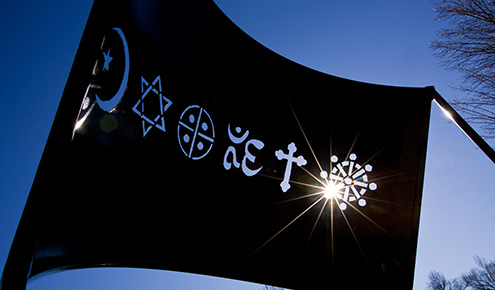
From the Moravian Lovefeast to the Muslim Feast of Sacrifice, students from many faiths celebrate their religious traditions at Wake Forest. Elena Schacht, a junior health and exercise science major from Stamford, Conn., shares her tradition of Hanukkah. Schacht is president of Hillel, the Jewish student organization at Wake Forest, and a student-athletic trainer in the sports medicine department.
What is the meaning of Hanukkah?
Hanukkah celebrates the ability of the Jews in ancient times to resist assimilation and stand up for their faith. When the Jews lit an oil lamp to mark the rededication of the Temple in Jerusalem, they only had enough oil for one day. But the lamp lasted for eight days, which was the “Miracle of Hanukkah” and led to the holiday being known as the festival of lights.
What is the biggest myth you’ve encountered about Hanukkah?
People of other faiths often assume that because Hanukkah is in the same season as Christmas, it is automatically the most important Jewish holiday. The most important Jewish holidays are “High Holidays” such as Rosh Hashana (the Hebrew New Year) and Yom Kippur (Day of Atonement). Hanukkah is celebrated nightly for eight nights with the lighting of candles and presents. Kids usually get one each for the eight nights, but as you get older the presents dwindle and become less and less exciting. Presents are not a traditional part of the celebration, and many believe they were just added in to give Jewish kids a holiday equivalent to Christmas.
Are there certain foods associated with Hanukkah?
As with any good holiday, there are many deliciously unhealthy foods associated with Hanukkah. Because the holiday basically celebrates oil, everything we eat is fried! There are sufganiyot (jelly donuts) and latkes (potato pancakes). There is also Hanukkah gelt (the Yiddish term for money), which is little chocolate coins that are meant to symbolize the newly won independence of the Jewish people.
What is the meaning of the Hanukkah Menorah?
The Hanukkah Menorah, or hanukkiah, symbolizes the light that was burned in the temple after it was reclaimed. The menorah has nine candles, one for representing each day, and one that is used as only a “helper candle.” Each night, an additional candle is added and lit until the entire menorah is filled and glowing.
How is the dreidel used?
A dreidel is a little spinning top with four sides. Each of the four sides has a Hebrew letter that corresponds to the saying “A Great Miracle Happened There,” where “there” refers to Israel (Fun fact: in Israel, the dreidels say “A Great Miracle Happened Here”). There is a gambling game you can play with it where each of the letters stands for the amount of coins you win. The story has it that when Jews were not allowed to practice their religion, they kept a dreidel handy and pretended to be playing this game whenever they were in fear of getting caught.
Were you concerned about differences in faith backgrounds when you chose to come to Wake Forest?
I was a little worried about religious differences. I knew that Wake Forest was historically a Baptist school, and I was unsure if that would make it uncomfortable as a Jewish student. When I entered as a freshman, I had a friend from home that was a junior, and also Jewish. She helped me out immensely through my first two years on campus. If another Jewish student were to express concerns about this to me, I would tell them to absolutely come to school at Wake Forest. Everyone here has been extremely welcoming.
What do you feel are the greatest opportunities on campus for students who are members of non-Christian faiths?
Being a religious minority has given me the opportunity to share my religion with all of my Christian friends. Everyone has been extremely interested in Judaism, and I get to teach all of my friends about something they may not have had any exposure to previous to college.
Categories: Community, Life on Campus
Headlines
Wake Forest in the News
Wake Forest regularly appears in media outlets around the world.




